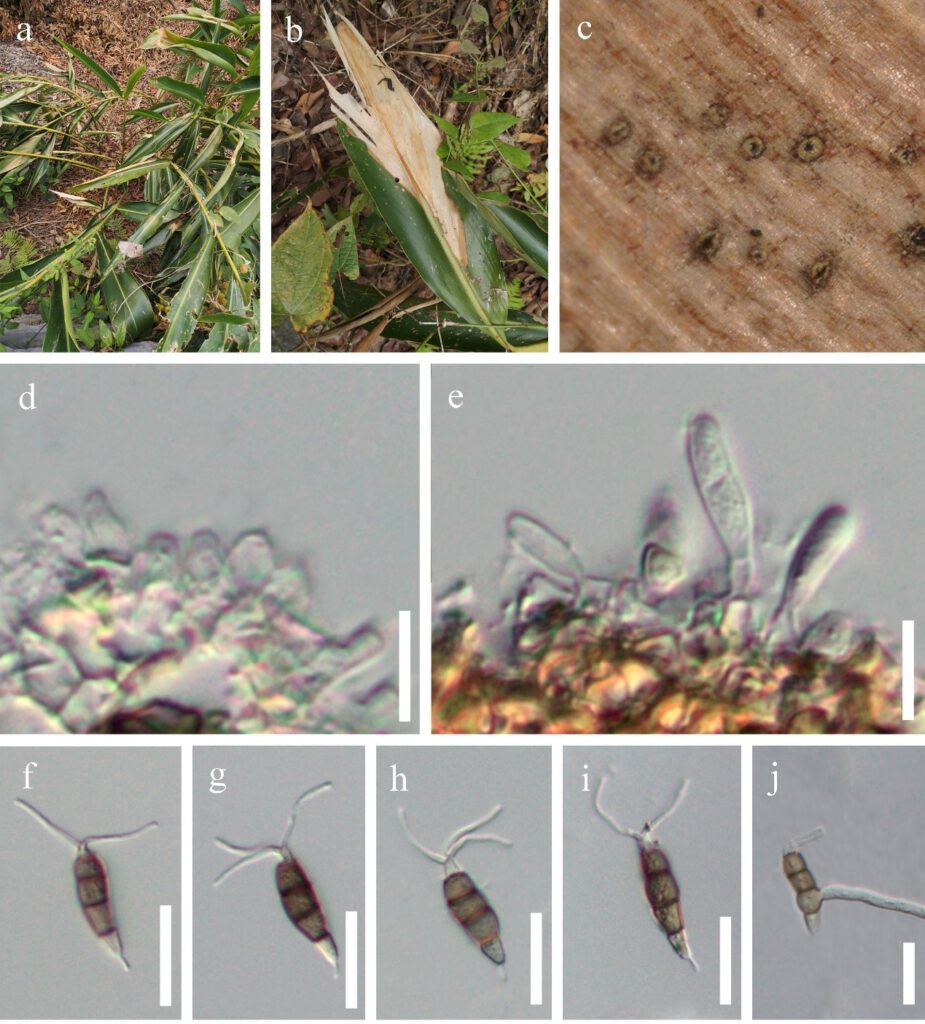Neopestalotiopsis amomi Y.R. Sun & Yong Wang bis, in Sun, Jayawardena, Sun & Wang, Microbiology Spectrum: e03987-22, 2 (2023)
Index Fungorum number: IF 571230; MycoBank number: MB 571230; Facesoffungi number: FoF 12912;
Etymology – Refers to the name of the host plant from which the fungus was isolated.
Holotype – HKAS 124563
Associated with leaf blight of Amomum villosum. Symptoms: irregular shape, pale to brown, slightly sunken spots appear on the leaves of Amomum villosum, which later expand outward. Sexual morph: not observed. Asexual morph: Conidiomata solitary, subglobose to globose, unilocular, brown, semi-immersed on leaves. Conidiophores 3 to 5 μm long, often reduced to conidiogenous cells. Conidiogenous cells 1 to 2 μm wide, subcylindrical, ampulliform, hyaline. Conidia 18 to 30 × 4 to 7 μm (x̄ = 25 × 6 μm, n = 40), length/width (L/W) ratio of 4.2, fusiform, straight to slightly curved, 4 septate; basal cell obconic with a truncate base, hyaline, smooth walled, 3 to 7 μm long; three median cells 12 to 19 μm long (x̄ = 16 μm, n = 40), pale brown to brown, concolorous, wall rugose, septa darker than the rest of the cell; second cell from base pale brown to brown, 3 to 8 μm long; third cell pale brown to brown, 3 to 7 μm long; fourth cell pale brown to brown, 3 to 7 μm long; apical cell 2 to 5 μm long, hyaline, conic to acute; with 2 to 3 tubular appendages on the apical cell, inserted at different loci in a crest at the apex of the apical cell, unbranched, 7 to 17 μm long; single basal appendage, unbranched, tubular, centric, 2 to 5 μm long.
Culture characteristics – Conidia germinated on PDA within 12 hours from single-spore isolation. Colony diameter reached 8 cm after two weeks at 25 ℃ on PDA media, circular, surface rough, flat, white from above and below.
Material examined – China, Guizhou Province, Qiannan Buyei and Miao Autonomous Prefecture, Luodian District, leaf blight of Amomum villosum Lour. (Zingiberaceae), 3 September 2021, Y.R. Sun, L8 (HKAS 124563, holotype); ex-type-living cultures, GUCC 814, ibid., on leaf blight of Amomum villosum, 3 September 2021, Y.R. Sun, L8-1 (HKAS 124564); living cultures, GUCC 815.
Notes – Neopestalotiopsis amomi was isolated from the diseased leaves of Amomum villosum in China. Two collections HKAS 124563 and HKAS 124564 clustered together with good support (ML-BS = 100%, BYPP = 1) and formed a sister clade to N. zingiberis (GUCC 21001), which was also isolated from a Zingiberaceae plant (43). The former differs in producing thinner conidia (4 to 7 μm in N. amomi versus 6 to 9.5 μm in N. zingiberis) and shorter conidiophores (3 to 5 μm in N. amomi versus 12 to 25 μm in N. zingiberis). In addition, there are 4 bp different between HKAS 124563 and GUCC 21001 in the ITS gene and 10 bp different in the tef1-α gene. Neopestalotiopsis amomi also differs by smaller conidia (18 to 30 × 4 to 7 μm versus 42 to 46 × 9.5 to 12 μm) from N. magna. The PHI test on N. amomi indicated that there is no significant recombination (Фw = 0.06) between N. amomi and its closely related taxa. Thus, we introduce N. amomi as a new species.

Figure 3 – Neopestalotiopsis amomi (MFLU 22-xx, holotype). a Host. b Leaf blight on Acrostichum aureum. c Close up view of conidiomata. d conidiogenous cells. e Immature conidia attached to conidiogenous cells. f–i Conidia. j Germinated conidium. Scale bars: d, e = 10 µm, f–j = 20 µm.
